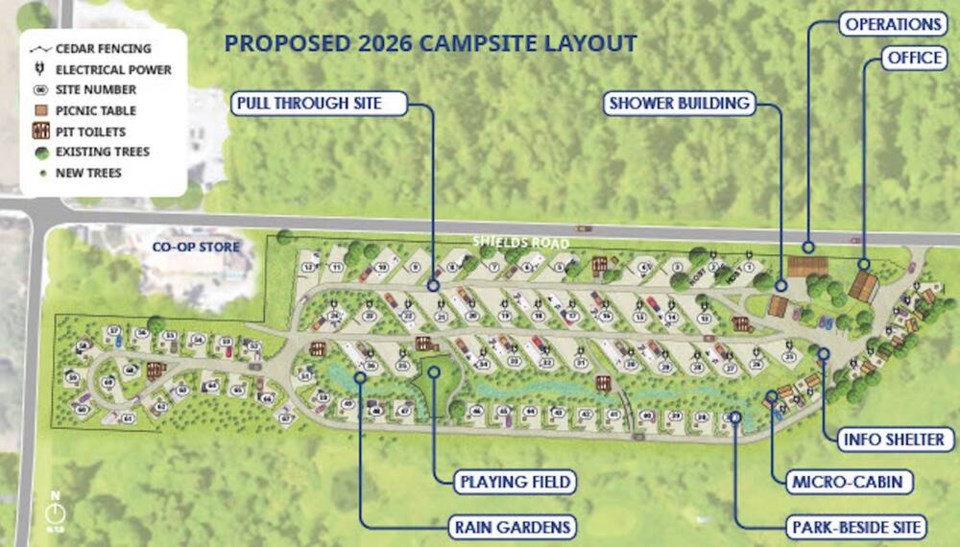B.C. Parks plans to dismantle the cramped formerly private Tribune Bay campground on Hornby Island, and spread sites out over a wider area.

For the thousands of campers who flock to the sandy beaches and warm, shallow waters of Tribune Bay Provincial Park on Hornby Island, it will be business as usual this summer.
But major changes are coming next year and beyond, as B.C. Parks dismantles the cramped formerly private campground, reducing the number of sites on the existing property and spreading campers out into new areas of the provincial park.
The province acquired the 116-site, eight-acre private campground and a 16-acre parcel of undeveloped forest land and beachfront in 2021.
Since then, B.C. Parks has been consulting with locals, First Nations and user groups on how best to utilize the new land. It has completed an ecological overview, tree assessments and an inventory of invasive species, and is continuing archaeological digs with First Nations.
Amy Ross, section head for B.C. Parks North Island, said tenders to redevelop the existing campground closed this week, and a contractor will be selected to carve up and re-purpose the site starting in the fall.
By next summer, there will only be about 67 sites available for use, and wood-burning campfires will be banned, she said. Only propane appliances will be allowed in the park starting in 2026 to provide “healthier air” and reduce the risk of wildfires.
Ross said the rebuilt campground will have more space and privacy between sites in the same footprint.
“We want it to have more of a B.C. Parks feel with more privacy … we heard from the public that’s really important,” she said.
The redesigned sites will include a variety of sizes, including pull-through sites for vehicles and camper vans, and the park will also offer small basic cabins.
Some sites will be electrified, and new pit toilets and a pay shower facility with conservation fixtures are being built to preserve water, which is a major concern on most Gulf Islands.
The access road to the campsite will also be improved, the site will be gravelled and a playground feature will be installed, said Ross, adding the goal is to eventually provide the same total number of campsites as originally existed in the park.
B.C. Parks is exploring locations to build another 40 campsites as part of a second phase during the fall and winter of 2026 and 2027.
Those sites could include walk-in and cycle-in sites that would discourage the use of larger RVs that put pressure on the ferry system, said Ross.
Camping could be expanded into newly acquired forested and marsh land north of Shields Road, which was in B.C. Parks’ original plan, or on the current site of the Tribune Bay Outdoor Education Centre within the park.
The centre, which includes a lodge, some cabins and camping areas, has been used as an outdoor learning classroom by Courtenay and Qualicum school districts for three decades under a park permit.
However, last October, the districts decided not to renew the permit, citing concerns about the state of infrastructure on site, costs and staffing.
Ross said the majority of the facilities on the site belong to the districts, so B.C. Parks is still determining what it would keep.
She said both options for new sites are still possibilities. “We’ve done extensive environmental studies on the newly acquired property and we’re doing the same at the outdoor education centre,” she said. “We’re not making any assumptions right now.
Ross said next year camping will be tight until a location for the 40 additional sites is determined.
“We’re doing our best to find those additional sites and make them up as soon as possible, but we do have to make sure we do our due diligence and check for all the environmental and archaeological factors to make sure we’re building on the best site,” said Ross. “It’s a complex process and we want to make sure we get it right because once you start construction, there’s no going back.”
The province acquired two properties on either side of Shields Road for $11.2 million in 2021. The deal added the campground and forested land and foreshore — representing the last remaining beachfront on Tribune Bay — to the 235-acre Tribune Bay Provincial Park.
During the consultation process since, both in-person and online, the public has expressed concerns that increasing the number of campsites would put pressure on the ferry system and add to congestion on the island. There are also ongoing concerns about water scarcity on the island during the summer months.
Hornby Island has about 1,200 year-round residents, which swells to more than 6,000 during peak summer months.
Ross said maintaining the same number of campsites was crucial because B.C. Parks did not want to increase ferry traffic. It also hopes bike-friendly sites will reduce some vehicle traffic.
Ross added local residents are also concerned about the impact of construction activity this fall on the ferry system, so contractors are being encouraged to consider barge options.
B.C. Parks has done an overall drainage study, dug new wells and a septic system and completed an ecological assessment of the recently acquired land last year to reduce the impact on vegetation, wildlife and wetlands.
Nesting trees and culturally important food sources such as camas and Pacific crabapple trees will also be protected. Dangerous and dying trees will also be removed.
B.C. Parks has been posting updates on its project at Tribune Bay on itswebsite.
[email protected]